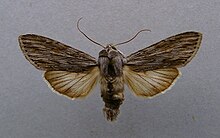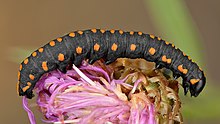You can help expand this article with text translated from the corresponding article in German. (October 2022) Click for important translation instructions.
|
| Cucullia lucifuga | |
|---|---|

| |

| |
| Caterpillar | |
| Scientific classification | |
| Domain: | Eukaryota |
| Kingdom: | Animalia |
| Phylum: | Arthropoda |
| Class: | Insecta |
| Order: | Lepidoptera |
| Superfamily: | Noctuoidea |
| Family: | Noctuidae |
| Genus: | Cucullia |
| Species: | C. lucifuga |
| Binomial name | |
| Cucullia lucifuga (Denis & Schiffermüller, 1775) | |
| Synonyms | |
| |
Cucullia lucifuga is a species of moth of the family Noctuidae. It is found in north, central and southern Europe east to Japan. It is also present in Tibet and Armenia.
The wingspan is 38–55 mm. There is one generation per year in the north, with adults on wing from May to June. In the warmer regions in the south, there is a second generation with adults on wing from July to August and a partial third generation with adults in October.
The larvae feed on various Asteraceae (or Compositae) species, including Tussilago farfara, Petasites paradoxus, Cirsium arvense, Centaurea phrygia, Sonchus arvensis, Hieracium umbellatum and Taraxacum species.
External links
| Taxon identifiers | |
|---|---|
| Cucullia lucifuga |
|
This Cuculliinae article is a stub. You can help Misplaced Pages by expanding it. |